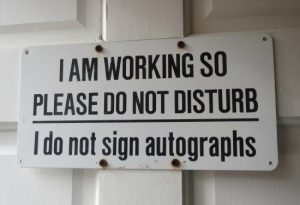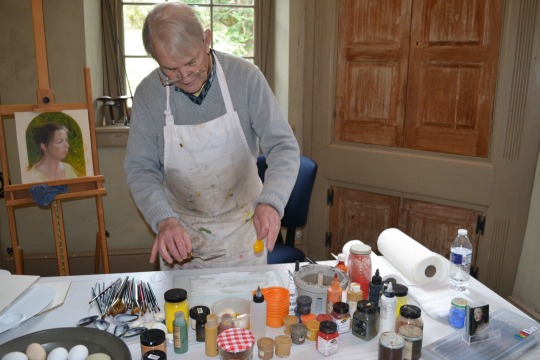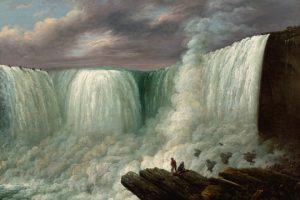Extra-large, white eggs from Wawa were the preferred poultry pick of renowned painter Andrew Wyeth, according to Brandywine River Museum of Art tour guide Jo Lurquin.

Their unmistakable impact on many of Andrew Wyeth’s most significant paintings resulted from Wyeth’s mastery of tempera, a painstaking technique. The process involves mixing pigment with distilled water and egg yolk to create paint conducive to exacting detail, Lurquin explained during a recent tour.
Those interested in viewing the procedure now have an opportunity. For the first time, the museum is offering demonstrations on Fridays in April during tours of Andrew Wyeth’s studio.
Artist Terry Wolf, a member of the Society of Tempera Painters, has set up shop temporarily in the studio, where he shows visitors the intricacies of the mixing regimen. Wolf paints on the Eastern Shore of Maryland and in Tenants Harbor, Maine. He studied at the Taylor School of Art in Wilmington, at the Barnes Foundation and with Maine artist John Dehlinger.

As Wolf cracks the first egg, the yolk breaks, forcing him to start over.
“You don’t want any of the white,” he explains as he gingerly cradles a yolk in his hand, gently piercing the sac so the yellow liquid runs into a small container. Once the yolk is extracted, it’s mixed with water in proportions that are not forgiving. Too much liquid and the result is runny; not enough egg produces a paint that’s too chalky, he explained.
The painting surface requires the same meticulous attention; ordinary canvas won’t work. Wolf said he often prepares his own boards, a process that takes three days per panel. He applies rabbit skin glue to the boards the first day, gesso the second day, and then sands them on the third.
“I just love it,” he said. Besides, “doing this keeps me out of bars,” he joked.
Wolf said he learned that Wyeth liked tempera because “you can keep on going and going.” Wolf said he could identify with that sentiment and has been known to buy back paintings he sold so that he can work on them a bit longer.

Unlike oil paints that can yellow with time, tempera keeps its color, Wolf said. He said the technique dates back at least as far as the Egyptians.
Because the process requires – and produces – precision, one might think that Andrew Wyeth’s studio would reflect that exactitude. That would be incorrect, Lurquin said.
“Enjoy the messiness of it all,” she added, pointing to random splotches of paint on the walls, floor, and ceiling of Wyeth’s workspace. “His son said he was a wild painter.”
Lurquin said esteemed painter N.C. Wyeth, Andrew’s father, bought the building in 1925, hoping that it would be used one day by one of his five children. Before that, the 1875 structure was known as Birmingham Township Schoolhouse No. 2, Lurquin said.
After their marriage in 1940, Andrew and Betsy Wyeth moved in, adding an expanded kitchen a decade later. In 1961, the Wyeths moved their family a few miles away, but Andrew Wyeth, who died in 2009, continued to use the studio through 2008, Lurquin said.
She said Wyeth appreciated the privacy the studio afforded him; sometimes he was even able to hide his car in the back, making it look unoccupied. Still, some diehards managed to seek him out, prompting a sign on the door that warned those intent on interrupting his work that he wouldn't be amenable to signing autographs.

When the museum acquired the property from Betsy Wyeth in 2010, she helped the museum recreate the living space, contributing memorabilia ranging from her cookbooks to her husband’s expansive collection of toy soldiers. The museum added other accouterments like ‘50s appliances and Revere pots and pans to lend authenticity, Lurquin said.
Throughout the studio, the walls are filled with Wyeth reproductions and photos. The photographs run the gamut from Wyeth’s fencing with actor Douglas Fairbanks Jr. to a collage of smiling portraits depicting Wyeth and Siri Erickson, one of his young models. “You can see their friendship,” Lurquin remarked.
Ann Magee traveled from New Jersey to take the tour. She explained that she’s working on a children’s picture book about Wyeth and thought the experience would be insightful. She particularly enjoyed Wolf’s demonstration.
“He’s fabulous and so talented,” Magee said of Wolf. “I could have listened to him a lot longer. I loved it.”
Patrick J. Murphy and his wife, Alessia Murphy, of Gilbertsville, said they are longtime Wyeth fans. Patrick Murphy said he spotted a notice on Facebook last week and they decided to attend.
“It was very interesting,” Alessia Murphy said. “I really enjoyed it.”
The Brandywine River Museum of Art will be offering historic property tours through Sunday, Nov. 20. Tours of the Andrew Wyeth Studio are available Monday, Wednesday, Thursday, Friday, Sunday at 10 and 11:15 a.m. and 12:45, 2 and 3:15 p.m.; and Tuesday and Saturday at 10 and 11:15 a.m. and 12:45 p.m. Wolf’s demonstrations will be included on April 15, 22, and 29.
Tours of the N. C. Wyeth House and Studio are available Monday at 10 and 11:15 a.m.; Thursday at 10 and 11:15 a.m. and 12:45 p.m.; and Tuesday, Wednesday, Friday, Saturday, Sunday at 10 and 11:15 a.m. and 12:45, 2 and 3:15 p.m. Tours of the Kuerner Farm are available Monday at 12:45, 2 and 3:15 p.m.; and Tuesday, Thursday and Saturday at 2 and 3:15 p.m.
Tickets are limited and available on brandywinemuseum.org or by calling 610-388-8326.
The Brandywine River Museum of Art, located on Route 1 in Chadds Ford, features an outstanding collection of American art housed in a 19th-century mill building with a dramatic steel and glass addition overlooking the banks of the Brandywine. The museum is open daily (except Thanksgiving Day and Christmas Day) from 9:30 a.m. to 5 p.m.




Comments